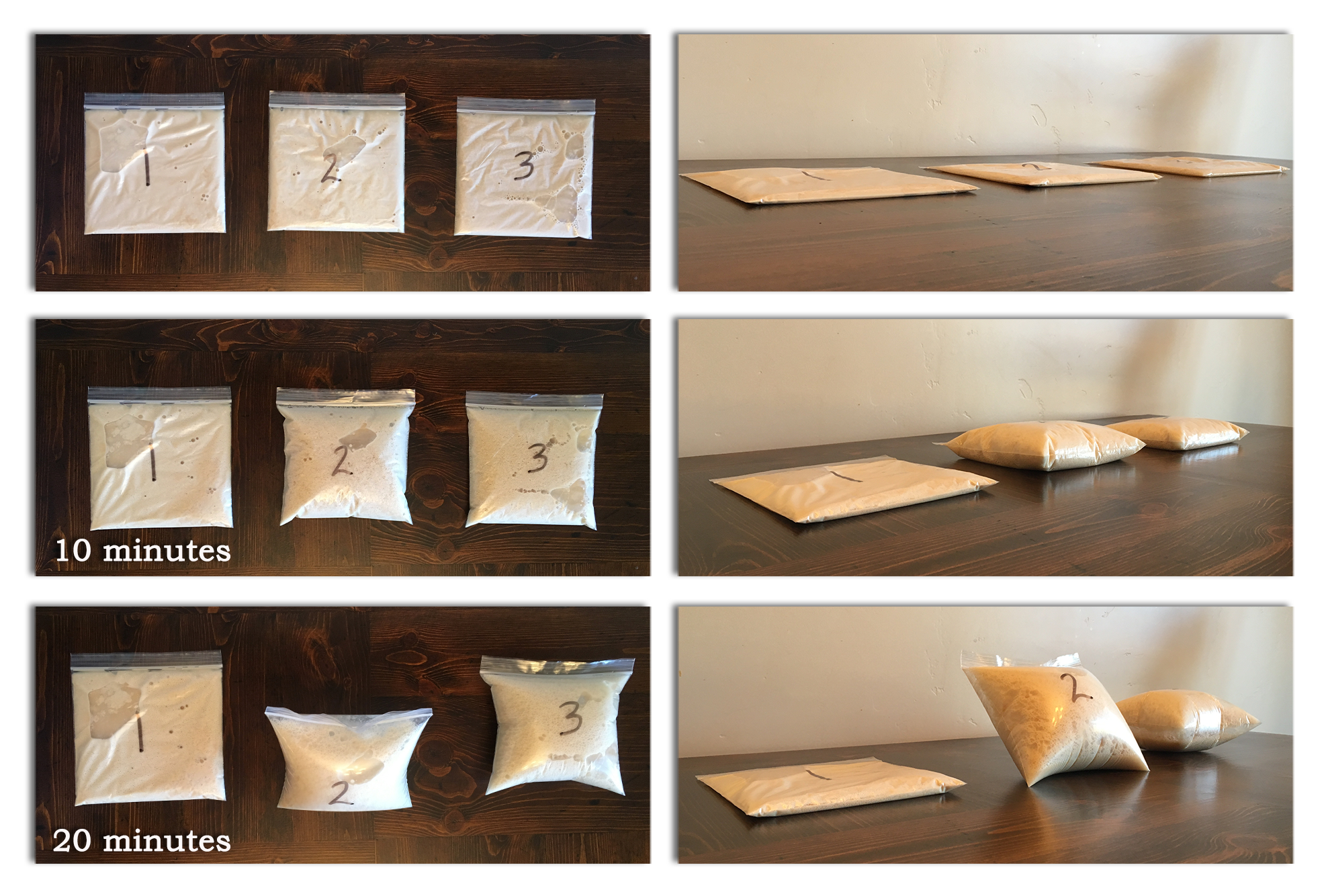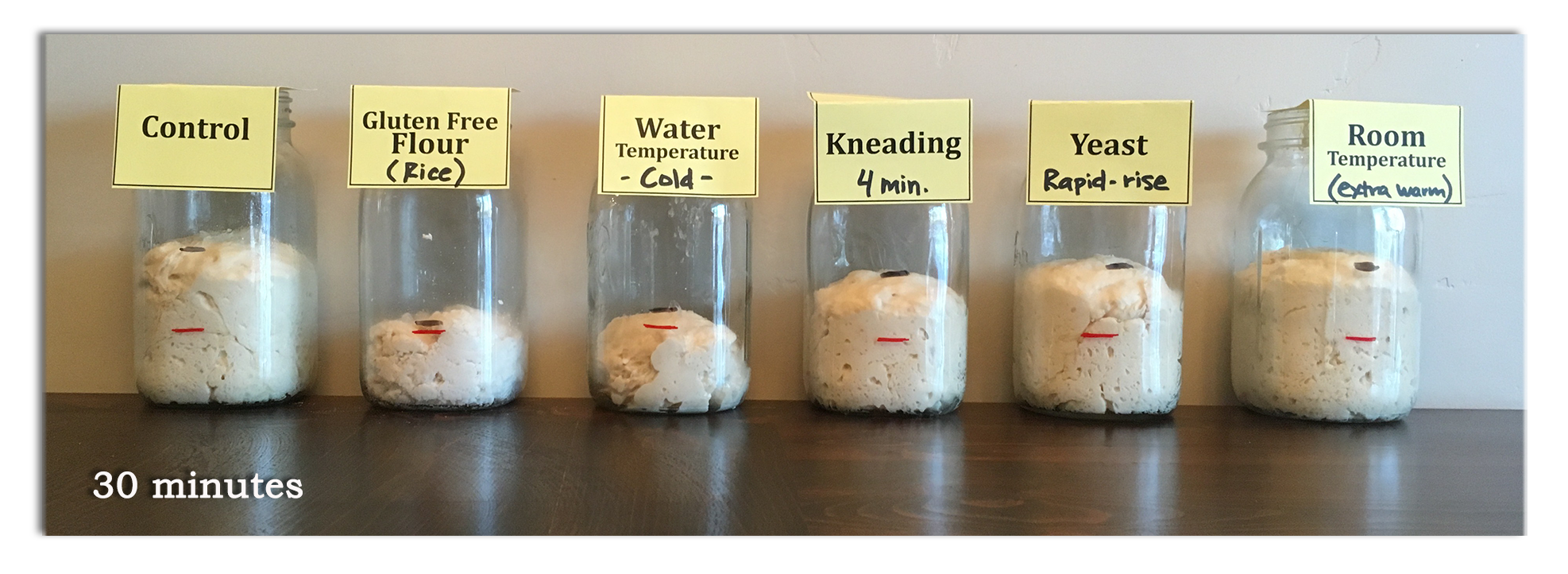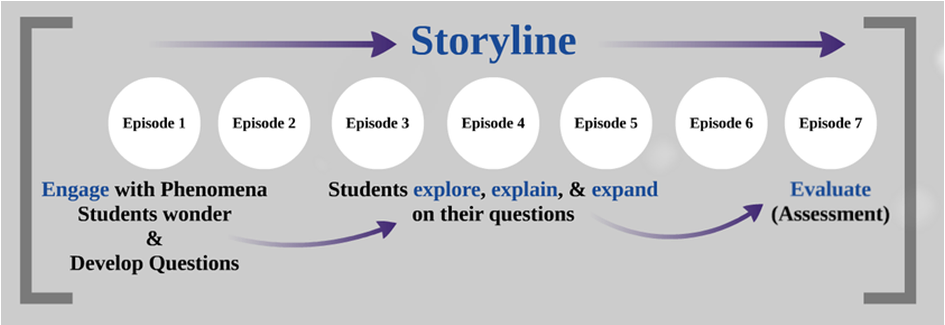Curriculum Matrix
Lesson Plan
Food Science: Bread Dough Challenge
Grade Level
Purpose
Students explore the phenomenon of what makes bread dough rise. Using baker's yeast, students will observe alcoholic fermentation and its connection to cellular respiration as they are challenged to act as food scientists and develop the best recipe for quick-rising bread dough. Grades 9-12
Estimated Time
Materials Needed
Engage:
Activity 1: What makes bread dough rise?
- 3 sandwich-sized Ziploc bags
- Yeast
- Warm water
- Sugar
- 1 tablespoon measuring spoon
- Food Science: Bread Dough Challenge handout, 1 per student
- Food Science: Bread Dough Challenge PowerPoint
Activity 2: Bread dough Challenge
- Food Science: Bread Dough Challenge handout, 1 per student (continued from Activity 1)
- Bread Dough Challenge Variables sheet, 1 copy per class printed front to back, cut into quarters
- Lab supplies for each group:
- 1 glass Mason jar or clear glass beaker
- 1 cup flour
- 1 tablespoon sugar
- 1/3 cup warm water
- 1 teaspoon active dry yeast
- 1 teaspoon cooking oil
- 1 plastic spoon for stirring
- 1 paper/plastic bowl for mixing
- Ingredients for bread rising variables: (specific needs based on which variables students choose)
- Rapid-rise yeast
- Vital wheat gluten
- 1 cup whole wheat flour
- 1 cup gluten-free flour (rice, coconut, oat, etc.)
- Sugar substitute such as Splenda
- Alternative sugar such as honey, brown sugar, or molasses
- Salt
Essential Files
Vocabulary
alcoholic fermentation: an anaerobic pathway that converts the pyruvate made in glycolysis to ethanol, produces CO2, and regenerates NAD
anaerobic: without the use of oxygen
asexual reproduction: a form of reproduction involving a single parent and producing offspring that are exact genetic duplicates
budding: a form of asexual reproduction where parent cell forms a bubble-like bud that stays attached to the parent cell while it grows and develops; then breaks away to form a new organism
cellular respiration: process by which cells release energy from glucose and convert it to ATP
food science: the study of the physical, biological, and chemical makeup of food and the concepts underlying food processing
gluten: a tough, elastic protein substance in flour, especially from wheat, that holds dough together and makes it sticky
lactic acid fermentation: an anaerbic pathway that converts the pyruvate made in glycolysis to lactic acid, regenerating NAD
Did You Know?
- It takes 9 seconds for a combine to harvest enough wheat to make about 70 loaves of bread.1
- Yeast are microorganisms. They are single-celled fungi.2
- Yeast produces carbon dioxide when it consumes sugar.3
- It takes 20 billion yeast cells to weigh one gram of cake yeast.4
Background Agricultural Connections
This lesson can be nested into a storyline as an episode exploring the phenomenon of bread dough rising. In this episode, students investigate the question, "What makes bread dough rise?" Phenomena-based lessons include storylines which emerge based upon student questions. Other lesson plans in the National Agricultural Literacy Curriculum Matrix may be used as episodes to investigate student questions needing science-based explanations. For more information about phenomena storylines visit nextgenstorylines.org.
Cellular respiration can be a difficult topic for students to understand because it cannot be directly observed. In this lesson, students who have studied the basics of aerobic cellular respiration will be introduced to alcoholic fermentation and will conduct a simple experiment to determine how yeast gets energy from sugar. Students who aren’t familiar with using yeast in baking may wonder if it’s alive, which is another great opportunity for discussion.
Yeasts are unicellular fungi that reproduce asexually. The species Saccharomyces cerevisiae is used in bread baking and wine and beer brewing. S. cerevisiae is also used as a model organism in many laboratories because it is easy and inexpensive to culture. It is a facultative anaerobe, meaning that it undergoes both aerobic and anaerobic fermentation. In the absence of oxygen, yeast and other organisms undergo alcoholic fermentation, producing CO2 and ethanol and regenerating the NAD+ needed to continue glycolysis. While this produces less ATP than aerobic respiration, some ATP is still produced.
Yeast cells do more than respire, they go through a form of asexual reproduction called budding. Asexual reproduction involves a single parent and results in offspring that are genetically identical to each other and to the parent. Budding occurs when a parent cell forms a bubble-like bud that stays attached to the parent cell while it grows and develops. Then, it breaks away and forms a new organism.
Students may be interested to learn that yeast is all around us; sourdough bread is made by allowing yeast in the air and in the flour to colonize a mixture of flour and water. The CO2 produced during yeast metabolism is captured in bread dough, causing it to rise. The protein gluten provides a structure for the bubbles of CO2. Kneading is necessary to develop and strengthen the crosslinks between gluten molecules. If dough is not kneaded enough, it won’t be elastic enough to capture the CO2 bubbles, resulting in a flat loaf. Gluten is not found in some grains, such as oats and rice. Students who try to make a dough with gluten-free flour may find that it won’t rise at all.
In Activity 2, students are challenged to act as food scientists to develop a recipe for quick-rising bread dough. Agricultural companies, like General Mills, Land O Lakes, and Cargill, challenge food scientists to utilize raw agricultural products as efficiently as possible to develop consumer-demanded food products. If Activity 2 must be broken up over two class periods, it might be helpful to have students mix together the dry ingredients of their dough (Step 11) on the first day so they are ready to start immediately on day two.
Engage
- Show the Time Lapse - Pizza Dough Rising video.
- Ask students, "What is causing this pizza dough to rise?" When students offer "yeast" as an answer, question further. For example, "What is yeast?" or "How does yeast make dough rise?"
Explore and Explain
|
This lesson investigates the phenomenon of bread dough rising. Natural phenomena are observable events that occur in the universe that we can use our science knowledge to explain or predict. Phenomenon-Based Episode: What makes bread dough rise? |
Activity 1: What makes bread dough rise?
- Introduce yeast by passing around small Ziploc bags of yeast or displaying one at the front of the room. Ask students if they know what it is and what it is used for. If no one knows, explain that it is yeast and that our primary use for it is in cooking.
- Provide a class demonstration of how yeast works using the following steps:
- Fill 3 quart or sandwich sized ziploc bags with 1 tablespoon of yeast per bag.
- Add 1 tablespoon of sugar to bag two and 3 tablespoons of sugar to bag three. (Bag 1 will serve as the control and will not have any sugar.)
- Place 1/2 cup of warm water in each bag and mix the contents thoroughly with your fingers.
- Push the air out of the bag and seal tightly.
- Place bags in a central area for observation.
- While the yeast is rising, give each student one copy of the Food Science: Bread Dough Challenge handout and project the corresponding PowerPoint.
- Tip: It will take approximately 20 minutes for the ziploc bags to fully inflate. However, exact time will vary depending on the temperature of your classroom. The next steps may be interchanged as needed for class flow.
- Using PowerPoint slides 2-5, discuss the answers to the four questions contained on the first page of the handout.
- Return to your observation of the ziploc bags. Discuss why the first bag did not inflate and why bags two and three did. Compare bags two and three. Did more sugar yield more expansion of the bag? If not, discuss possible reasons why.
- Safety Note: Be sure to open the ziploc bags before they pop.
- Using the second page of the handout, draw on students' prior knowledge and have them answer the questions about how various organisms obtain energy.

|
Three Dimensional Learning Proficiency: Crosscutting Concepts Students link different domains of science fields into a coherent and scientifically-based view of the world. Cause and Effect: Events have causes, sometimes simple, sometimes multifaceted. Deciphering causal relationships, and the mechanisms by which they are mediated, is a major activity of science and engineering. |
Activity 2: Bread Dough Challenge
- Ask students if they can name any food products that are made using yeast and alcoholic fermentation. Examples include bread, beer, and wine.
- Tell students that one of the challenges to making bread (at home or on the industrial scale) is the time that it takes to allow the dough to rise. Food scientists use engineering, biology, and chemistry to evaluate and improve food products from the farm to the kitchen.
- Tell students that they are on a team of food scientists at a bread company. They will be working together to discover the best recipe and preparation procedures to produce quick rising bread. To test as many variables as possible, the class will be divided into small groups.
- Divide your class into 8-12 groups and assign each group one Bread Dough Challenge Variable. You can use any of the variables provided, or have students think of their own. Preselect the optional variables based on your class size and/or lab supplies available.
- Explain to the class that one group will use the original recipe found in their Food Science: Bread Dough Challenge handout. This will serve as the experiment's "control." The remaining groups will change one variable and the remaining dough samples will be compared at the end.
- Tip: As students determine their variables and how they will manipulate them for the experiment, allow them to pursue the wrong direction to provide an authentic learning experience and the opportunity to explain the outcome using science. For example, knowing that yeast needs sugar to grow, a student may greatly increase the amount of sugar in the recipe. If the yeast is not increased, this sample will not rise faster. It may not rise as much or even at all depending on the ratio. Refer to information about the molar concentration of sucrose for an explanation.
- Provide lab supplies, answer student questions, and tell students where to take their dough once it is mixed. Have students fold their variable card in half to make a tent label to identify their dough.
- Using a dry erase marker, have each group place a starting line on their jar at the level of the dough.
- Allow at least 30 minutes for the bread dough to rise. Instruct students to place a second line at the level of the dough after 30 minutes.
- Place all dough jars for students to observe. After observation time is over, allow students time to complete the last page of their handout which will contain their final recommendation to the bread company.

| Help students avoid the misconception that yeast simply "grows" or becomes larger. Be sure they recognize what is happening on the cellular level which is budding, a form of asexual reproduction. Illustrate with a video. |
Elaborate
- Have students complete the attached Cellular Respiration concept map. Print the blank diagram (page 1) or the diagram with hints (page 2). Students can use a textbook or internet search to complete the diagram. The word bank on page 3 can also be projected or printed for reference. The teacher key is found on page 4.
- Discover other foods that are created using the process of fermentation. Examples include cheese, sauerkraut, pickles, kimchi, and root beer. Divide the class into small groups. Assign each group to research a specific fermented food and create a "how to" brochure outlining how the food is made.
- Show students where wheat is grown in the United States. Use the wheat map from the Interactive Map Project. Find your state and determine how much wheat your state grows annually.
- Have students create a graph of their data and the control from Activity 2. Students can create the graph by hand or by using graphing software such as Google Spreadsheets or Microsoft Excel. Have each group display their graph to the class.
Evaluate
After conducting these activities, review and summarize the following key concepts:
- Food Science is a career area in agriculture. Many agricultural companies employ food scientists to develop raw agricultural commodities into marketable food products.
- Science is used to produce and process our food. The process of alcoholic fermentation is used in making bread dough.
- Bread dough rises as yeast processes sugar and produces carbon dioxide, the gas that makes the dough rise.
- Gluten is the protein found in wheat flour.
Sources
- https://mobile-cuisine.com/did-you-know/bread-fun-facts/
- https://wiki.kidzsearch.com/wiki/Yeast
- http://www.ilove2bake.co.za/learn-more-about-yeast-6-8-interesting-facts/
- https://redstaryeast.com/science-yeast/what-is-yeast/
Acknowledgements
This lesson was originally written by Ann Butkowski for Minnesota Agriculture in the Classroom. It was updated and revised in 2019 by the National Center for Agricultural Literacy.
Phenomenon chart adapted from work by Susan German.
German, S. (2017, December). Creating conceptual storylines. Science Scope, 41(4), 26-28.
German, S. (2018, January). The steps of a conceptual storyline. Science Scope, 41(5), 32-34.
Recommended Companion Resources
Author
Organization
| We welcome your feedback! If you have a question about this lesson or would like to report a broken link, please send us an email at matrixelearning@gmail.com. If you have used this lesson and are willing to share your experience, we will provide you with a coupon code for 10% off your next purchase at AgClassroomStore. |

